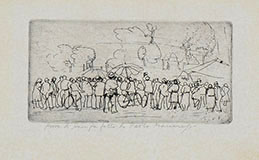BOLOGNA 1908 - 1991
Manaresi studied at the Art School of Bologna, later enrolling in the Decoration course of Achille Casanova at the local Academy of Fine Arts, where he graduated in 1929. In 1934 he moved to Varallo Sesia, in the province of Vercelli, where he taught at the local Art School. During this period the artist turned his attention to sculpture, creating works that were certainly not negligible, but all irretrievably lost during the war. From 1942 he was in Cascina, in the province of Pisa, and only in 1945 did he return to Bologna where he taught at the Art School. His return was marked by the events of the war that deeply affected Manaresi who oriented his painting towards expressionist results. In the meantime, from 1949, encouraged by Morandi, he began to take an interest in etching, which in the space of a few years would bring him international fame, absorbing almost all of his activity. In the same year he participated, still as a painter, in the Venice Biennale with the painting Frate pittore, later purchased by the Galleria comunale d’arte moderna in Bologna. In 1952 he held his first solo exhibition of etchings at the Galleria Cairola in Milan, followed the following year by a large monographic exhibition ordered by Carlo Alberto Petrucci at the Calcografia Nazionale in Rome. He subsequently participated as an engraver in countless exhibitions both in Italy and abroad, distinguished by official recognition, among which the prize for engraving at the Venice Biennale in 1954 stands out. He succeeded Morandi in the chair of Engraving at the Academy of Bologna in 1958, after having taught the same subject in the Academy of Florence for the two previous years.

